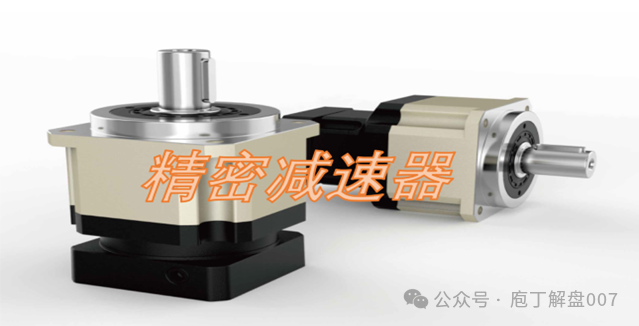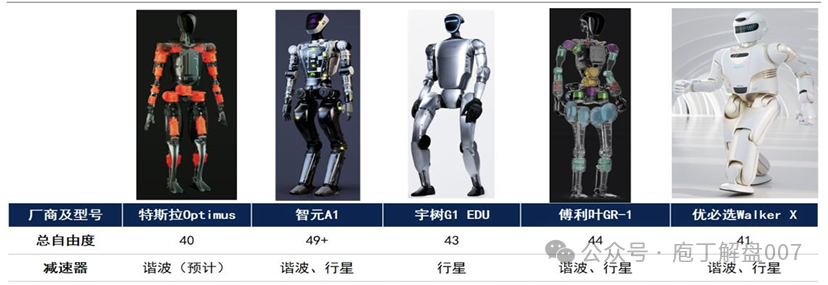Core Logic:
Precision reducers are one of the three core components of robots, accounting for nearly 30% of the total cost of robots, and are known as the “mechanical joints”. Currently, most mainstream humanoid robot manufacturers use a combination of harmonic reducers and precision planetary reducers. It is expected that the future demand for humanoid robots at the million-unit level will be several times greater than the current market size, indicating significant growth potential. Humanoid robots are currently in the stage of large-scale production, with a focus on companies that have technological advantages and are the first to establish production capacity for precision reducers.
Related Companies:
Green Harmonic, Zhongda Leader, Double Ring Transmission, Haozhi Electromechanical, Siling Co., Ltd., Longsheng Technology, Southern Precision, Qinchuan Machine Tool, Julun Intelligent, Fengli Intelligent, and Ruidi Intelligent Drive, etc.

01 Basic Concept of Reducers
Reducers, also known as speed reducers, serve to reduce speed and increase torque between motors and actuators, primarily used in mechanical transmission fields. Generally, reducers achieve speed reduction by engaging a small gear on the input shaft with a larger gear on the output shaft, thereby transmitting greater torque to facilitate the transmission between the prime mover and the actuator.
In simple terms, when the output speed of the motor is input from the driving shaft, it drives the small gear to rotate, which in turn drives the large gear. Since the number of teeth on the large gear is greater than that of the small gear, the speed of the large gear is slower than that of the small gear, and the output is taken from the shaft of the large gear (output shaft), thus achieving the purpose of speed reduction.
Reducers can be classified into general transmission reducers and precision reducers based on their application scenarios. General transmission reducers have low control precision and can meet the basic power transmission needs of general mechanical equipment; precision reducers are high-precision, high-reliability transmission devices characterized by small size, light weight, high precision, and strong stability, capable of achieving precise control in mechanical transmission, mainly used in high-end manufacturing fields such as robots, new energy equipment, high-end machine tools, and electronic devices.
Figure 1 Simple Diagram and Classification of Reducers

02 Classification and Characteristics of Precision Reducers
Precision reducers play a crucial role in robots, similar to human joints, serving as the core power transmission mechanism, accounting for nearly 30% of the cost. Based on different working principles, precision reducers can generally be classified into harmonic reducers, RV reducers, and precision planetary reducers, each applied to different parts of robots.
——Harmonic Reducers operate on the principle of using a wave generator to create controllable elastic deformation in the flexible wheel, transmitting motion and power through engagement with the rigid wheel. This process achieves high precision and a large transmission ratio. Harmonic reducers are compact, simple in structure, have a high reduction ratio, and high transmission accuracy, but have poor wear resistance, commonly used in lightweight parts of robots, such as forearms, wrists, and dexterous hands.。
——Planetary Reducers are based on gear transmission principles, consisting of a sun gear, planet gears, an internal gear, and a planet carrier, characterized by compact structure, high rigidity, high precision, and high transmission efficiency. Planetary reducers are often used on servo motors to reduce speed, increase torque, and achieve precise positioning, commonly used in robot joints that require lower precision.。
——RV Reducers are a composite reduction device with a complex structure, including involute planetary gear transmission and cycloidal pin wheel planetary transmission, characterized by high load capacity, high output torque, and high precision. RV reducers are commonly used in heavy-load parts of robots, such as upper arms, shoulders, and legs.
Figure 2 Three Major Types of Precision Reducers

03 Market Size and Competitive Landscape of Harmonic Reducers
(1) Market Size and Growth Rate
According to Business Research Insights, the global harmonic reducer market size in 2023 is estimated to be $440 million, and it is expected to reach $500 million (approximately 3.5 billion RMB) in 2024, with a growth rate of 15%.
In the domestic market, according to the domestic company Green Harmonic, the revenue from harmonic reducers in 2023 is approximately 290 million, with a domestic market share of 21%, estimating the domestic market size to be around 1.38 billion, and the harmonic reducer market size in 2024 is expected to reach 1.6 billion, with a growth rate of 20%.
(2) Competitive Landscape
Data shows that in 2021, the main participants in the global harmonic reducer market included Harmonic Drive (Japan), Nabtesco (Japan), and Green Harmonic. Harmonic Drive held approximately 82% of the global market share, while Green Harmonic accounted for about 7%, and other manufacturers made up about 11%.
In the domestic market, the top five companies in the harmonic reducer market in 2023 held about 78% of the market share, with Harmonic Drive at 29%; Green Harmonic, Laifu Harmonic, Dazhu, Nabtesco, and Tongchuan Technology holding market shares of 21%, 11%, 10%, 7%, and 6%, respectively, indicating a relatively concentrated market competition. With national policy support, technological upgrades in the industry, and factors such as high cost-performance ratios and continuous capacity expansion, the market share of domestic companies is expected to further increase.
Figure 3 Global and Domestic Market Shares of Harmonic Reducers (%)

04 Market Size and Competitive Landscape of RV Reducers
(1) Market Size and Growth Rate
RV reducers are widely used in the industrial robot field. A six-axis robot typically requires 3-4 RV reducers when the load is 20 kg, while the demand for RV reducers is even higher in handling robots with larger load capacities.
According to Business Research Insights, the global RV reducer market size is expected to reach $2.91 billion (approximately 20.3 billion RMB) in 2024, with a growth rate of about 11%; according to data from Guanyan Tianxia, the domestic RV reducer market size is expected to reach 4.29 billion RMB in 2024, and is projected to reach 5.57 billion RMB in 2025, with a year-on-year growth of 30%.
(2) Competitive Landscape
According to Huajing Industry Research Institute, in 2023, the top three companies in the global RV reducer market held about 83% of the market share, with Nabtesco (Japan) accounting for 61.4%, Sumitomo Heavy Industries (Japan) at 17.5%, and SPINEA (Slovakia) at 4.1%.
In the domestic market, the top five companies held about 80% of the market share, including Nabtesco (53%), Double Ring Transmission (14%), Sumitomo Heavy Industries (5%), and Feima Transmission (4%). Other companies such as Zhongda Leader and Nantong Zhenkang also produce RV reducers in bulk.
Figure 4 Global and Domestic Market Shares of RV Reducers (%)

05 Market Size and Competitive Landscape of Precision Planetary Reducers
(1) Market Size and Growth Rate
Statistics show that from 2018 to 2022, the global market size of precision planetary reducers grew from $900 million to $1.2 billion, with a compound annual growth rate (CAGR) of 7.5%. It is expected that by 2024, the global market size of precision planetary reducers will reach $1.45 billion (approximately 10.15 billion RMB), with a CAGR of 10.0%.
In the domestic market, from 2018 to 2022, the market size of precision planetary reducers in China increased from $300 million to $500 million, with a CAGR of 13.6%. It is expected that by 2024, the market size of precision planetary reducers in China will grow to $650 million (approximately 4.55 billion RMB), with a growth rate of about 14.5%.
(2) Competitive Landscape
In 2022, the top five companies in the global precision planetary reducer market were Nabtesco/Nidec, Neugart (Germany), Wittenstein (Germany), Precision Technology (Taiwan), and Kofun Intelligent (China), with market shares of 12.9%, 10.9%, 10.7%, 7.5%, and 5.4%, respectively.
In the domestic market, the top five companies in the precision planetary reducer market in 2022 were Nabtesco/Nidec, Kofun Intelligent, Neugart, Precision Technology, and Liming (Taiwan), with market shares of 20.4%, 11.7%, 9.4%, 7.1%, and 5.3%, respectively.
Figure 5 Global and Domestic Market Shares of Precision Planetary Reducers

06 Precision Reducer Solutions of Mainstream Humanoid Robot Manufacturers
These three types of precision reducers differ in application principles, structural composition, and characteristics, and there are certain differences in the subfields of robot applications. Different robot manufacturers adopt different reducer solutions based on the characteristics and costs of different reducers. Currently, the mainstream solution is a combination of harmonic reducers and planetary reducers, while RV reducers are not disclosed by mainstream humanoid robot manufacturers due to their higher costs and larger sizes.
——TeslaOptimus Gen-2: 40 degrees of freedom, using 14 harmonic reducers and 12 planetary reducers.
——Zhi Yuan ExpeditionA1: 49 degrees of freedom, using a harmonic integrated joint paired with a self-developed joint motor PowerFlow, integrating and optimizing the reducer, motor, and motor driver, with the reducer scheme paired with a high-torque transparent planetary reducer.
——YushuG1: 43 degrees of freedom, using a three-finger force-controlled dexterous hand, mainly using planetary reducer schemes at the joints.
——UBTECHWalkerX: 41 degrees of freedom, with key joints using harmonic reducers. The company has applied for multiple patents related to harmonic and planetary reducers.
——FourierGR-1: 44 degrees of freedom, using a highly integrated design of the FSA actuator (integrating motor, driver, reducer, and encoder) as joint drive, with patents for harmonic and planetary reducer joints.
Figure 6 Degrees of Freedom and Reducer Solutions of Major Robot Manufacturers

07 Elastic Estimation of Demand for Precision Reducers Driven by Humanoid Robots
Based on the above analysis, the current global market size for precision reducers is approximately: harmonic reducers 3.5 billion RMB; RV reducers 20.3 billion RMB; planetary reducers 10.15 billion RMB, totaling approximately 34 billion RMB.
The domestic market size is approximately: harmonic reducers 1.6 billion RMB; planetary reducers 4.55 billion RMB; RV reducers 4.29 billion RMB, totaling approximately 10.4 billion RMB.
The existing precision reducers are primarily driven by industries such as industrial robots, while humanoid robots, due to the significant increase in degrees of freedom, are expected to greatly enhance market size. If we assume that the total global sales of humanoid robots will reach 1 million units by 2028, with an average of about 30 reducers per robot, and the average price drops to 1000 RMB per unit, the market space for reducers in the humanoid robot field is expected to reach 30 billion RMB, representing an 88% increase over the current global market size for precision reducers, and several times the current domestic market size.
If we further simply assume a 5:5 ratio of harmonic reducers to planetary reducers, the specific segmented market elasticity is as follows:
(1) Harmonic Reducers
Assuming a unit price of 1300 RMB, with an average usage of 15 units, the corresponding market demand for 1 million units would be approximately 15 million units, resulting in a market size of 19.5 billion RMB, which is more than five times the current global market size of 3.5 billion RMB.
(2) Planetary Reducers
Assuming a unit price of 700 RMB, with an average usage of 15 units, the corresponding market demand for 1 million units would be approximately 15 million units, resulting in a market size of 10.5 billion RMB, which is nearly double the current global market size of 10.15 billion RMB.
08
Companies Related to Precision Reducers
(1Harmonic Reducers
Green Harmonic:Leading in harmonic reducers, ranked second globally, with a production capacity of 300,000 units/year by the end of 2021. In 2023, plans to build a new generation of harmonic reducers with a capacity of 1 million units, bringing total capacity to 1.59 million units.
Haozhi Electromechanical:Harmonic reducer business operated independently by its subsidiary, Haozhi Transmission, with an annual production capacity of 150,000 units by April 2024.
Longsheng Technology:Acquired Weihan Intelligent to become a holding subsidiary, focusing on the R&D and industrial application of precision harmonic reducers and integrated joint actuators.
Siling Co., Ltd.:Focusing on the R&D and mass production of harmonic reducers, core equipment is expected to be in place by the end of 2024, with small-batch production starting after installation and debugging.
Hanyu Group:Holding company Tongchuan Technology (18.9% stake) has a domestic market share of 6%, with a shipment volume exceeding 50,000 units in 2024, supporting Yushu Technology and Zhi Yuan Robotics.
Fengli Intelligent:Company’s harmonic reducer progress is smooth, with production lines expected to be completed in late 2023, and all conventional models developed, entering small-batch production phase.
Ruidi Intelligent Drive:Produces precision transmission components, electromagnetic brakes, and harmonic reducers as key components of automation equipment transmission and braking systems, mainly applied in CNC machine tools, robots, elevators, etc.
(2Planetary Reducers
Northern Precision:Through its subsidiary, it is laying out planetary reducer modules, providing “bearing + planetary gear” combination solutions for leading manufacturers such as Tesla Optimus.
Zhihui Electromechanical:Developed a series of products including hollow cup motors, planetary gearboxes, and high-torque brushed DC motors.
Ningbo Dongli:Previously responded on Interactive Easy, currently mainly producing medium to large planetary reducers.
Haoneng Co., Ltd.:Based on process and customer homogeneity, further vertically expanding the planetary reducer business, currently actively laying out planetary reducers for humanoid robots.
(3RV Reducers
Double Ring Transmission:Products from its subsidiary, Huandong Technology, mainly include RV reducers and harmonic reducers, currently holding the top market share in domestic RV reducers.
Zhongda Leader:Offers RV reducers, harmonic reducers, and planetary reducers, with an annual production capacity of approximately 100,000 RV reducers.
Qinchuan Machine Tool:Is the only supplier of a full range of RV reducer products in China, with significant advantages in high-end markets both domestically and internationally, with a designed capacity of approximately 180,000 units.
Julun Intelligent:Initial production capacity level of 10,000 units, with RV reducers characterized by high precision, low noise, and smooth operation, showing significant advantages in cost performance.
Disclaimer:This article is for personal learning purposes only and does not constitute any investment advice. Many of the information cited in the text are compiled from publicly available information on the internet, and all judgments are based on personal subjective assumptions, which may inevitably contain many errors and omissions. Please operate at your own risk. The stock market has risks, and investment requires caution!
